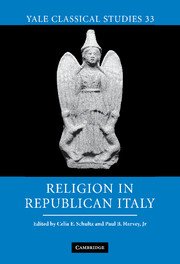Book contents
- Frontmatter
- Contents
- List of illustrations
- List of contributors
- Acknowledgments
- List of abbreviations
- Introduction
- Chapter 1 Reconsidering “religious Romanization”
- Chapter 2 In search of the Etruscan priestess: a re-examination of the hatrencu
- Chapter 3 Etruscan religion at the watershed: before and after the fourth century bce
- Chapter 4 Religious locales in the territory of Minturnae: aspects of Romanization
- Chapter 5 Religion and memory at Pisaurum
- Chapter 6 Inventing the sortilegus: lot divination and cultural identity in Italy, Rome, and the provinces
- Chapter 7 Hot, cold, or smelly: the power of sacred water in Roman religion, 400–100 bce
- Chapter 8 Religion and politics: did the Romans scruple about the placement of their temples?
- Chapter 9 Juno Sospita and Roman insecurity in the Social War
- Chapter 10 Beyond Rome and Latium: Roman religion in the age of Augustus
- Bibliography
- Index
Chapter 7 - Hot, cold, or smelly: the power of sacred water in Roman religion, 400–100 bce
Published online by Cambridge University Press: 08 January 2010
- Frontmatter
- Contents
- List of illustrations
- List of contributors
- Acknowledgments
- List of abbreviations
- Introduction
- Chapter 1 Reconsidering “religious Romanization”
- Chapter 2 In search of the Etruscan priestess: a re-examination of the hatrencu
- Chapter 3 Etruscan religion at the watershed: before and after the fourth century bce
- Chapter 4 Religious locales in the territory of Minturnae: aspects of Romanization
- Chapter 5 Religion and memory at Pisaurum
- Chapter 6 Inventing the sortilegus: lot divination and cultural identity in Italy, Rome, and the provinces
- Chapter 7 Hot, cold, or smelly: the power of sacred water in Roman religion, 400–100 bce
- Chapter 8 Religion and politics: did the Romans scruple about the placement of their temples?
- Chapter 9 Juno Sospita and Roman insecurity in the Social War
- Chapter 10 Beyond Rome and Latium: Roman religion in the age of Augustus
- Bibliography
- Index
Summary
INTRODUCTION
The topic of water, sacred water, and cults connected with water is important to all studies of ancient religion, but is particularly relevant for our understanding of Roman and Italic society during the last four centuries of the Roman Republic. That the religious importance of water went well beyond its visual appeal or practical use is clear from the ancient sources, both literary and archaeological. Throughout Italy, from the beginning of time, the presence of springs, streams, rivers, and lakes has created the character of the landscape. Wherever these natural water sources appear, we are likely to find remains of sacred areas, ranging from isolated votive deposits to monumental sanctuaries. Along roads, at river crossings, and along mountain passes, the presence of water reinforces the link between nature and the divine.
The power of sacred water is reflected in beliefs and practices that illustrate both Rome's uniqueness and its dependence on the religious traditions of Italy as a whole. Furthermore, the study of sacred water at sites outside the city enhances our understanding of the term “Roman” within the context of Rome's neighbors in central Italy and throughout the peninsula. This is especially true for Etruria where, during the period 400–100 bce, the Roman presence spread rapidly and widely to the point that Roman values and religious practices may have merged with those that were exclusive to the Etruscans.
- Type
- Chapter
- Information
- Religion in Republican Italy , pp. 162 - 180Publisher: Cambridge University PressPrint publication year: 2006
- 8
- Cited by



